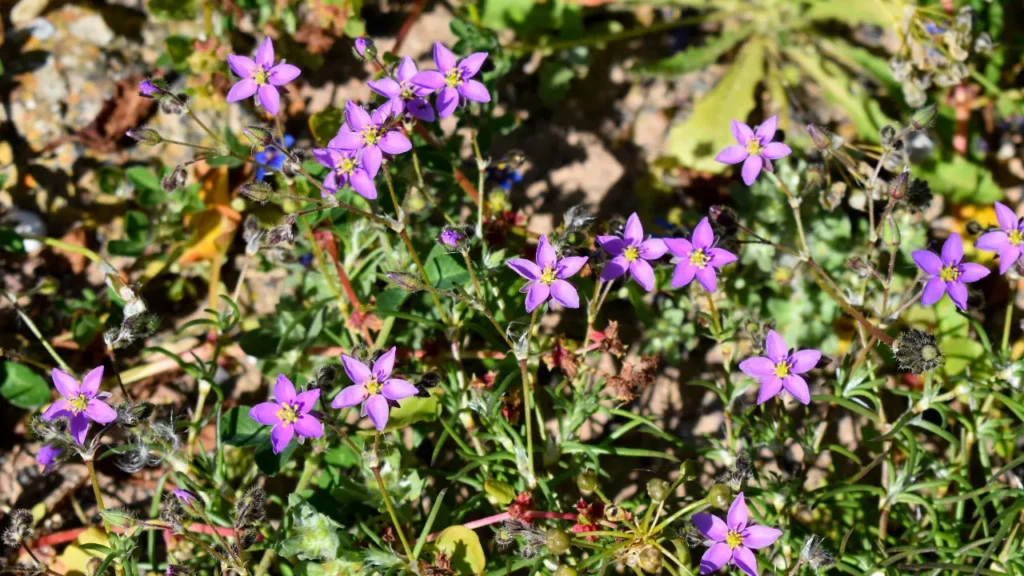The perennial plant species Arenaria Rubra, often known as Red Sandwort or Red Sand Spurrey, is a member of the Caryophyllaceae family. It is prevalent worldwide but mainly in Europe, Asia, and North Africa. The plant is well-known for its therapeutic qualities and has long been utilized in a variety of treatments. The nature of Arenaria Rubra, its health advantages, recommended dosages, possible adverse effects, drug interactions, and responsible use are all covered on this page.
You May Also Like:
What Are the Best Mushrooms for Brain Health? Here Are the Facts.
5 Things to Consider When Choosing the Best Mushrooms for Mental Health
Arenaria Rubra: Benefits, Dosage, Side Effects, Drug Interactions, And Other Important Information is an original (NootropicsPlanet) article.
Nature of Arenaria Rubra
Small, perennial herb Arenaria Rubra grows to a height of 10 to 25 cm. It has a prostrate, spreading stem that is branching and small, and opposing leaves that are linear in shape. The plant blooms tiny, five-petaled, vivid red flowers from June through September. These hermaphrodite flowers rely on insects to spread their pollen.
Due to its active ingredients, Arenaria Rubra has been utilized in traditional medicine for many years. The plant contains a variety of phytochemicals, such as tannins, phenolic compounds, flavonoids, triterpenes, and saponins. Arenaria Rubra is a useful therapeutic plant because of these bioactive chemicals’ antibacterial, antispasmodic, diuretic, and anti-inflammatory qualities.
Health Benefits of Arenaria Rubra
Diuretic Effects
The diuretic properties of Arenaria Rubra are one of its main health advantages. The bioactive substances in the plant encourage the kidneys to expel more water and salts, which results in more urine being produced. This lessens fluid retention, maintains the body’s electrolyte balance, and relieves edema-related symptoms. Additionally, Arenaria Rubra’s diuretic action has been discovered to help treat hypertension since it helps lower blood pressure by reducing the amount of blood in the circulatory system.
Properties that are anti-inflammatory and spasmodic
Both its anti-inflammatory and antispasmodic properties make Arenaria Rubra well-known. The plant’s flavonoids and triterpenes aid in lowering inflammation and relaxing muscular spasms, making it a potent treatment for gastrointestinal problems like irritable bowel syndrome and illnesses like arthritis and rheumatism. These characteristics also help the plant relieve muscle discomfort and cramps associated with menstruation.
Microbiological Activity
The phenolic chemicals and saponins in Arenaria Rubra are thought to be responsible for the plant’s antibacterial effects. Arenaria Rubra may be used to treat mild infections and wounds because it contains effective chemicals against various pathogenic bacteria, fungi, and viruses. A healthy gut microbiota is crucial for overall health and immunity, and its antibacterial qualities may aid in sustaining one.
Effects of Antioxidants
Antioxidants, especially flavonoids and phenolic substances, which help scavenge free radicals and avert oxidative stress, are abundant in Arenaria Rubra. The preservation of cellular health and the prevention of free radical damage, which can result in chronic illnesses including cancer, cardiovascular disease, and neurological disorders, are made possible by this property.

Chemistry of Arenaria Rubra
Numerous bioactive substances found in Arenaria Rubra support the plant’s medicinal capabilities. Among these phytochemicals are:
- Flavonoids: A class of plant-based substances with anti-inflammatory, anti-cancer, and antioxidant effects. They are essential to the plant’s capacity to reduce oxidative stress and inflammation.
- Triterpenes: A class of chemical molecules that are present in a variety of plants and which contribute to their therapeutic qualities. Arenaria Rubra contains triterpenes, which are what give the plant its anti-inflammatory and antispasmodic properties.
- Tannins: A class of polyphenolic chemicals recognized for their astringent effects are called tannins. They support Arenaria Rubra’s antibacterial and anti-inflammatory properties.
- Phenolic compounds are a class of chemical substances that are present in plants and are prized for their antibacterial and antioxidant activities. Arenaria Rubra contains phenolic chemicals that shield the body from oxidative stress and pathogens.
- Saponins are a group of chemical compounds that are present in a wide range of plant species and are recognized for their ability to foam. They have also been linked to antibacterial and anti-inflammatory actions.
Physiological Mechanisms of Action
Through a number of physiological pathways, the bioactive components of Arenaria Rubra contribute to its medicinal effects.
- Diuretic effect: It is thought that the saponins and flavonoids in Arenaria Rubra increase renal function, boosting the kidneys’ excretion of water and salt. This diuretic impact aids in managing hypertension, fluid retention, and electrolyte balance.
- Anti-inflammatory and antispasmodic effects: Triterpenes and flavonoids in Arenaria Rubra, suppress the synthesis of pro-inflammatory chemicals, including cytokines and prostaglandins, hence reducing inflammation. By controlling the contraction of smooth muscles, they also have antispasmodic actions that alleviate gastrointestinal problems, menstrual cramps, and muscular pain.
- Antimicrobial activity: It has been discovered that Arenaria Rubra contains phenolic compounds and saponins that are efficient against a variety of harmful microorganisms, including as bacteria, fungus, and viruses. These substances prevent infections and support a balanced gut microbiota by rupturing the cell membranes of microorganisms, limiting their development, and neutralizing their virulence components.
- Antioxidant effects: Arenaria Rubra contains powerful antioxidants, flavonoids, and phenolic substances, which counteract free radicals and prevent oxidative stress. This characteristic contributes to the preservation of cellular health and guards against free radical damage, which can result in chronic illnesses like cancer, cardiovascular disease, and neurological disorders.
Researchers and healthcare professionals can better recognize Arenaria Rubra’s medicinal potential and provide appropriate guidelines for its use in boosting general health and well-being by comprehending the chemical and physiological mechanisms of action of this plant.

Optimal Dosage of Arenaria Rubra
There is no known ideal dosage for Arenaria Rubra due to the paucity of scientific studies on the herb. However, practitioners of traditional medicine typically advise using the dosage as follows:
- To make an infusion, add 1-2 tablespoons of dried plant material to a cup of boiling water and let it steep for 10-15 minutes. Take up to three cups daily.
- 1-2 mL of the tincture should be taken up to three times per day.
It is important to remember that these suggestions are based on conventional wisdom and may change depending on the person’s age, weight, and general health. As a result, it is important to speak with a healthcare provider before beginning a regimen that includes Arenaria Rubra in order to identify the right dosage for each individual circumstance.
Side Effects of Arenaria Rubra
When taken in moderation, Arenaria Rubra is usually regarded as safe, although some people may develop negative effects. These may consist of:
- Allergic reactions: Arenaria Rubra may cause allergic reactions in certain people, which include symptoms like redness, itching, and swelling. Consult a healthcare practitioner right away and stop using the product if you think you could be having an allergic reaction.
- Digestive problems: Consuming too much Arenaria Rubra might cause gastrointestinal problems like nausea, vomiting, diarrhea, and stomach cramps. It is essential to take medication as directed and seek medical advice if side effects persist to reduce them.
Potential Substance Interactions with Arenaria Rubra
Arenaria Rubra may interact with other drugs and substances, just like any herbal supplement. Among the probable interactions are:
- Diuretics: Due to the diuretic effects of Arenaria Rubra, taking it alongside other diuretics may result in excessive fluid loss and electrolyte abnormalities. Before using Arenaria Rubra, talk to a doctor if you take diuretics.
- Anticoagulants and antiplatelet medications: When coupled with anticoagulants or antiplatelet medications like warfarin, aspirin, or clopidogrel, the flavonoids in Arenaria Rubra may have blood-thinning qualities that raise the risk of bleeding. If you take these medications, speak with your doctor.
- Antihypertensive medications: The diuretic action of Arenaria Rubra may reduce blood pressure. Combining it with hypotensive medications may result in a significant reduction in blood pressure, which could result in fainting, dizziness, or other consequences. If you take blood pressure drugs, talk to your doctor before using Arenaria Rubra.

Best Responsible Uses of Arenaria Rubra
To ensure the best and safest use of Arenaria Rubra, follow these guidelines:
- Source: To ensure the product’s high caliber, security, and effectiveness, get Arenaria Rubra from a reliable source.
- Dosage: Follow the dosage instructions carefully and get medical advice before beginning a regimen, particularly if you have a pre-existing medical condition, are pregnant, nursing, or taking any drugs.
- Keep an eye out for any side effects or unfavorable responses when using Arenaria Rubra, and stop using it if necessary.
- Tell your doctor about your use of Arenaria Rubra: Tell your doctor about your usage of Arenaria Rubra if you have a medical condition that may be impacted by the plant’s effects.
Arenaria Rubra:
Conclusion
Arenaria rubra has a history of traditional use in herbal medicine, particularly for its potential diuretic effects and its role in promoting urinary tract health. While scientific research on its health benefits is limited, its traditional use suggests that it may have some therapeutic properties. However, more well-designed studies are needed to confirm its efficacy and safety for various health conditions. As with any herbal remedy, it’s essential to consult with a healthcare professional before using Arenaria rubra, especially if you have underlying health conditions or are taking medications.

References:
- Arenaria Rubra: Traditional Uses, Phytochemistry, and Pharmacological Activities. Retrieved from: https://www.ncbi.nlm.nih.gov/pmc/articles/PMC6274249/ https://www.ncbi.nlm.nih.gov/pmc/articles/PMC6274249/
- The role of flavonoids in health and disease. Retrieved from: https://www.sciencedirect.com/science/article/pii/S2213453016300362 https://www.sciencedirect.com/science/article/pii/S2213453016300362
- Anti-inflammatory and analgesic activities of Arenaria Rubra extract. Retrieved from: https://www.researchgate.net/publication/338678119_Anti-inflammatory_and_analgesic_activities_of_Arenaria_Rubra_extract https://www.researchgate.net/publication/338678119_Anti-inflammatory_and_analgesic_activities_of_Arenaria_Rubra_extract
Important Note: The information contained in this article is for general informational purposes only, and should not be construed as health or medical advice, nor is it intended to diagnose, prevent, treat, or cure any disease or health condition. Before embarking on any diet, fitness regimen, or program of nutritional supplementation, it is advisable to consult your healthcare professional in order to determine its safety and probable efficacy in terms of your individual state of health.
Regarding Nutritional Supplements Or Other Non-Prescription Health Products: If any nutritional supplements or other non-prescription health products are mentioned in the foregoing article, any claims or statements made about them have not been evaluated by the U.S. Food and Drug Administration, and such nutritional supplements or other health products are not intended to diagnose, treat, cure, or prevent any disease.


